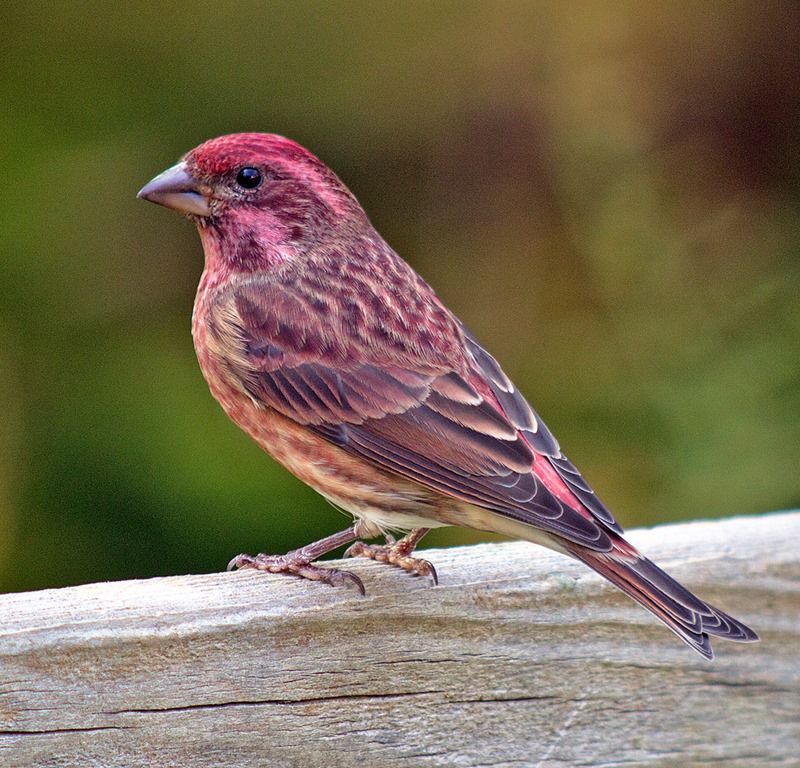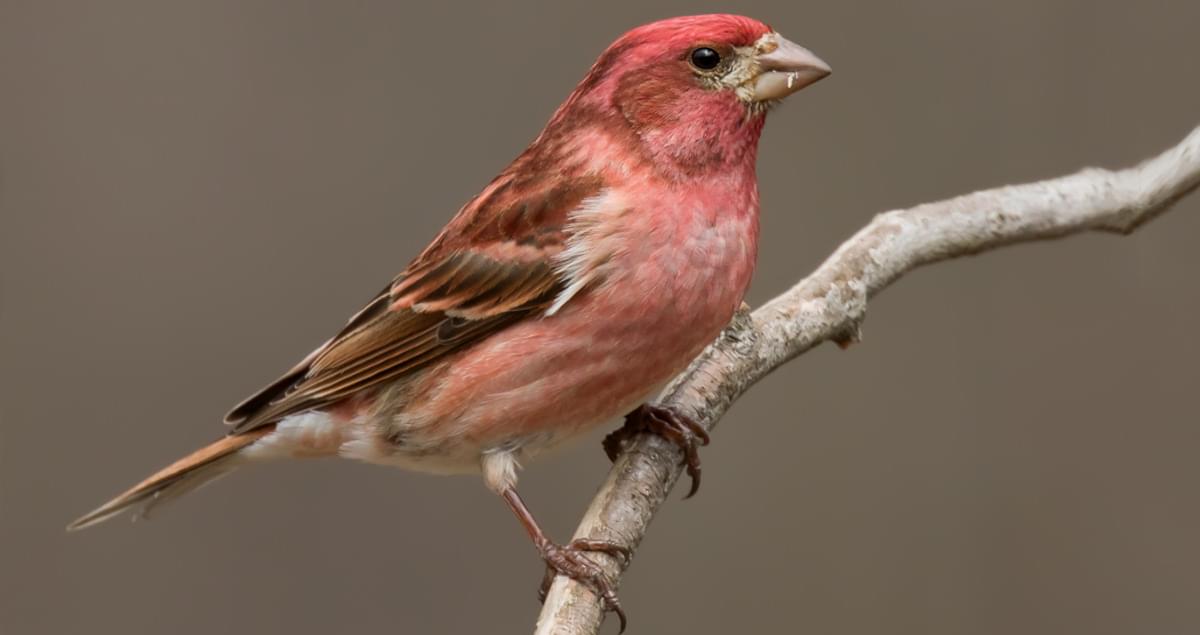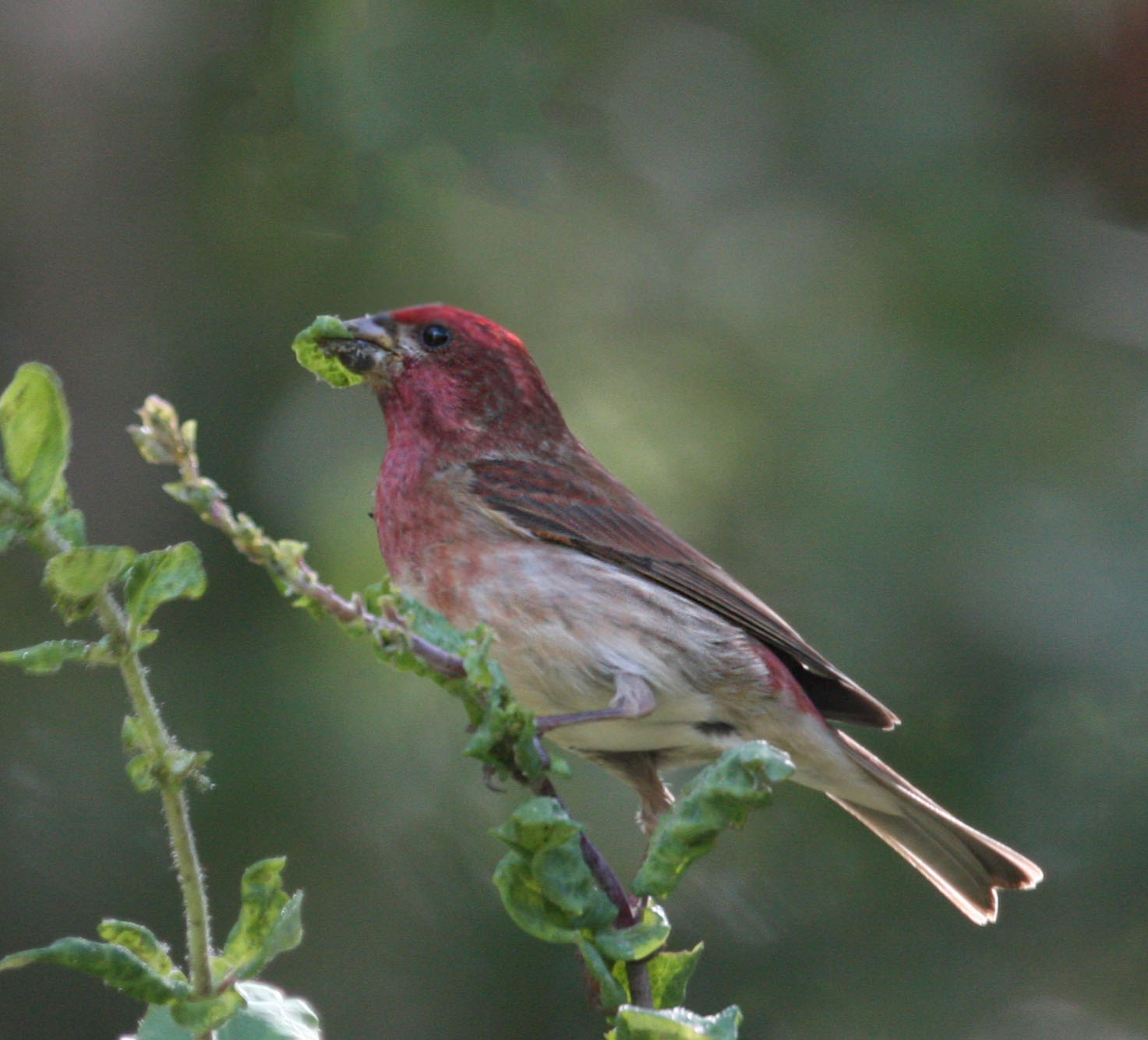Discover The Raspberry-Red Jewel: Your Guide To The Purple Finch
Have you ever caught a glimpse of a small bird, its head and breast seemingly dipped in a vibrant shade of raspberry or spilled grape juice? If so, you've likely encountered the enchanting Purple Finch, a true gem of North American birdlife. Often mistaken for its more common cousin, the House Finch, this delightful songbird possesses a unique charm and a fascinating life story that sets it apart. Understanding the nuances of its appearance, behavior, and habitat can transform a simple bird sighting into a moment of genuine discovery.
This comprehensive guide will take you on a journey into the world of the Purple Finch. We'll delve into the subtle yet crucial details that distinguish it from similar species, explore its preferred breeding grounds and wintering habitats, uncover its intriguing feeding habits, and even witness its unique courtship rituals. Prepare to enhance your birdwatching skills and deepen your appreciation for this colorful feathered resident.
Table of Contents
- Unveiling the Purple Finch: A Splash of Raspberry Red
- Purple Finch vs. House Finch: Decoding the Differences
- Where the Purple Finch Calls Home: Habitat and Distribution
- The Daily Life of a Purple Finch: Behavior and Social Habits
- Courtship and Nesting: The Purple Finch's Mating Rituals
- What's on the Menu? The Purple Finch's Diet
- The Purple Finch in the Grand Scheme: Taxonomy and Conservation
- Welcoming Purple Finches to Your Yard: Feeder Tips
Unveiling the Purple Finch: A Splash of Raspberry Red
The **Purple Finch** is a small finch, immediately recognizable by its robust, conical bill perfectly adapted for cracking seeds. But what truly sets it apart, especially the male, is its stunning plumage. Imagine a bird whose head and breast are generously suffused with a rich, raspberry-red hue. This isn't a mere patch of color; it's a deep, almost wine-like wash that extends across the crown, nape, and down to the chest. Compared to the more common House Finch, the male Purple Finch boasts an overall more vibrant and uniform coloration, particularly noticeable on its back and wings, where the red tones blend seamlessly without distinct streaking on the sides. Some observers describe the male's head as resembling "spilled grape juice," a testament to its unique and captivating shade. Females and juvenile Purple Finches, while lacking the male's flamboyant red, possess their own subtle beauty. They are typically streaky brown and white, with a prominent white eyebrow and a strong facial pattern that helps in identification. Both sexes share that distinctive conical bill, a hallmark of finches. Observing these birds, whether through detailed photos or by listening to their cheerful, warbling songs, offers a delightful experience for any bird enthusiast. Steve and Dave Maslowski's iconic image of a male Purple Finch sitting on a snowy branch in winter perfectly captures the species' striking beauty against a stark backdrop, highlighting its resilience and year-round presence in various parts of its range.Purple Finch vs. House Finch: Decoding the Differences
For many birdwatchers, distinguishing between a **Purple Finch** and a House Finch can be a genuine challenge. Both species exhibit stunning red and brown plumage, leading to frequent confusion. However, with a careful look at their range, color, and structure, you can learn the differences between these two similar finches. Separating them requires keen observation, but the reward is the satisfaction of identifying a truly unique and delicately colored bird.The Nuances of Color and Pattern
The most common point of confusion lies in the male birds. While both species display red, the quality and distribution of this color differ significantly. The male **Purple Finch** is often described as having a "raspberry red" or "wine-stained" appearance. This color is more evenly spread across its head, breast, and back, giving it a "dipped in paint" look. Crucially, Purple Finches lack the distinct brown streaks on their sides and flanks that are characteristic of House Finches. Their overall plumage appears cleaner and more uniformly colored, especially on the back and wings, which often show a richer, more saturated red. In contrast, the male House Finch typically displays a brighter, more orange-red color, which is usually concentrated on the head, breast, and rump, often with noticeable streaking on its belly and flanks. The red on a House Finch can also appear patchier, sometimes limited to the face and upper breast. For females, the distinction is even more subtle. Female Purple Finches tend to have a more pronounced facial pattern, often with a clear, bold white eyebrow and a less streaky underside compared to female House Finches, which generally appear more uniformly streaked below.Structural Clues and Range Overlap
Beyond color, structural differences provide reliable clues. The **Purple Finch** tends to be stockier, with a relatively larger head, a shorter tail, and a more robust, conical bill. Its overall silhouette can appear "bull-headed" compared to the House Finch's more slender profile. The House Finch, conversely, often has a longer tail and a somewhat smaller head in proportion to its body. Observing these subtle structural variations can be incredibly helpful when color alone is ambiguous. Their ranges also offer a hint, though there's significant overlap. Purple Finches primarily breed in coniferous or mixed forests across North America, favoring wooded areas. While they winter in a wider variety of habitats, including suburban areas and feeders, their breeding grounds are distinctly forest-oriented. Western Purple Finches, for instance, occur along the Pacific Coast from British Columbia to Baja California, often preferring moist, coniferous forests. House Finches, on the other hand, are highly adaptable and have successfully colonized urban and suburban environments across most of North America, often seen in backyards, parks, and city centers. While both may visit your feeder, understanding their typical breeding habitats can aid in identification.Where the Purple Finch Calls Home: Habitat and Distribution
The **Purple Finch** is a true denizen of the North American landscape, its distribution spanning a wide range across the continent. Understanding its preferred habitats and migration patterns is key to appreciating this species. These colorful songbirds primarily breed in coniferous or mixed forests, particularly favoring areas with spruce, fir, and pine trees. Their breeding range extends across Canada, the northeastern United States, and along the Pacific Coast. During the winter months, Purple Finches exhibit a wider variety of habitat preferences. While some remain in their northern breeding grounds, many migrate southward, spreading across much of the eastern and southern United States, and into parts of Mexico. During these non-breeding periods, they can be found in a more diverse array of environments, including deciduous woodlands, orchards, suburban parks, and even backyard feeders. This adaptability allows them to access a broader range of food sources when their primary forest diet becomes less available. The Western Purple Finch, a distinct population, is found specifically along the Pacific Coast, from British Columbia down to Baja California, often favoring coastal forests and woodlands. Studying distribution and habitat maps provides an excellent visual representation of their extensive range, highlighting the migratory routes and year-round presence of this resilient species.The Daily Life of a Purple Finch: Behavior and Social Habits
The **Purple Finch** is a lively and active bird, constantly foraging and interacting with its environment. Their daily life revolves around finding food, avoiding predators, and, during the breeding season, raising their young. In the wild, Purple Finches are adept foragers, searching for food both on the ground and high up in the foliage of trees and shrubs. Their strong conical bills are perfectly suited for cracking open the tough shells of seeds, which form a significant part of their diet. These finches are generally social birds, often seen in small flocks, especially outside the breeding season. This social behavior can be a strategy for coping with predators, as more eyes mean a better chance of spotting danger. They also exhibit interesting behaviors related to "irruptions," which are irregular, large-scale movements of bird populations from their usual ranges, often driven by food scarcity in their northern breeding grounds. During irruptive years, Purple Finches might appear in much larger numbers than usual at feeders or in areas where they are typically less common, providing a delightful surprise for birdwatchers. However, life isn't always easy for the Purple Finch. They face competition, particularly from the more aggressive and adaptable House Finch. This competition can impact their access to food sources, especially at feeders, and even influence nesting site availability in some areas. Despite these challenges, the Purple Finch demonstrates remarkable resilience, adapting its behavior to survive and thrive across its diverse range. If you're hoping to attract these colorful finches to your feeder, understanding their dietary preferences and providing a safe, welcoming environment can greatly increase your chances of a visit.Courtship and Nesting: The Purple Finch's Mating Rituals
The breeding season brings forth some of the most fascinating behaviors of the **Purple Finch**, particularly their elaborate courtship rituals. For these birds, courtship is far more than a brief display; it's a captivating performance orchestrated by the male to win the favor of a female. A male Purple Finch will engage in a charming "dance" in front of his prospective mate. This often involves a hopping performance, where he might balance on one foot while holding a piece of grass, straw, or a small twig in his bill. This delicate offering, combined with his vibrant plumage and melodic song, is designed to impress the female and signal his suitability as a mate. Once a pair bonds, they proceed with nesting. Purple Finches typically build their nests in coniferous or mixed forests, often choosing sites high up in trees, well-concealed among the branches. The female usually constructs the nest, a cup-shaped structure made from twigs, rootlets, and other plant materials, lined with finer grasses or hair. She will lay a clutch of 3-6 eggs, which she then incubates. The male takes on the role of providing food for the incubating female and, later, for the nestlings. The lifespan of a Purple Finch in the wild can vary, but with successful breeding and avoidance of predators, they can live for several years. Their mating habits and parental care are crucial for the continuation of the species, ensuring that future generations of these beautiful songbirds continue to grace the North American woodlands with their presence and distinctive calls.What's on the Menu? The Purple Finch's Diet
The diet of the **Purple Finch** is diverse and adaptable, primarily consisting of seeds and fruits, reflecting their classification as a finch. Their robust, conical bill is a specialized tool, perfectly designed for cracking open tough seed coats, allowing them to access the nutritious kernels within. In the wild, Purple Finches are opportunistic foragers, diligently searching for food both on the ground and higher up in the foliage of trees and shrubs. Their natural diet includes a wide array of seeds from various trees and weeds. They particularly favor the seeds and buds of coniferous trees like spruce, fir, and pine, which are abundant in their preferred breeding habitats. Beyond conifer seeds, they also consume seeds from deciduous trees, weeds, and grasses. Berries are another significant component of their diet, providing essential moisture and nutrients, especially during certain seasons. They will feast on the fruits of plants like sumac, honeysuckle, and various wild berries. While primarily herbivorous, Purple Finches are not exclusively so; they will also supplement their diet with insects, particularly during the breeding season when protein is crucial for their growing young. This varied diet allows them to thrive across different habitats and seasons, showcasing their adaptability and resilience.The Purple Finch in the Grand Scheme: Taxonomy and Conservation
Understanding where the **Purple Finch** fits into the broader avian family tree and its current conservation status provides valuable context for appreciating this species. It highlights its evolutionary journey and the efforts needed to ensure its continued survival.A Place in the Avian Family Tree
The **Purple Finch** is a distinguished member of the finch family, Fringillidae, a group of passerine songbirds known for their seed-eating habits and often vibrant plumage. Its scientific classification places it firmly within the biological hierarchy: * **Kingdom:** Animalia * **Phylum:** Chordata * **Class:** Aves * **Order:** Passeriformes * **Family:** Fringillidae * **Subfamily:** Carduelinae * **Genus:** *Haemorhous* * **Scientific Name:** *Haemorhous purpureus* Historically, there was some grouping of this species with "rose finches," but modern taxonomic research, based on genetic and morphological differences, has clarified its distinct position within the *Haemorhous* genus. This scientific name, *Haemorhous purpureus*, literally translates to "blood-red purple," a fitting description for the male's striking coloration. This classification underscores its unique evolutionary path and its relationship to other finch species.Conservation Status: Least Concern
Good news for bird enthusiasts: the **Purple Finch** is currently classified as "Least Concern" by the International Union for Conservation of Nature (IUCN). This status indicates that the global population of Purple Finches is not currently facing immediate threats that would put it at risk of extinction. This passerine songbird continues to grace the woodlands of North America with its vibrant plumage and melodic tunes, a testament to its adaptability and the resilience of its populations. However, "Least Concern" does not mean entirely without challenges. Like many species, Purple Finches face ongoing pressures from habitat loss and fragmentation, particularly in areas undergoing significant development. Moreover, competition from the highly successful and widespread House Finch can sometimes impact local Purple Finch populations, especially concerning food resources at feeders and nesting sites. While their overall numbers remain stable, continuous monitoring and habitat preservation efforts are essential to ensure the long-term health and vitality of the Purple Finch population across its extensive range.Welcoming Purple Finches to Your Yard: Feeder Tips
If you're eager to attract the beautiful **Purple Finch** to your backyard, setting up a bird feeder can be a rewarding experience. These finches are known to visit feeders, especially during the winter months or during irruptive years when natural food sources are scarce. Providing the right type of food and feeder can significantly increase your chances of spotting these raspberry-red jewels. Purple Finches primarily feed on seeds, and they have a strong preference for black oil sunflower seeds, which are rich in oil and easy for their conical bills to crack. Nyjer (thistle) seeds are also a favorite, especially when offered in specialized feeders designed for tiny seeds. Other seeds they might enjoy include safflower and shelled peanuts. Avoid cheap seed mixes that contain a lot of filler grains like milo or red millet, as these are often discarded by finches. When it comes to feeders, tube feeders with small perches or hopper feeders are excellent choices, as they keep seeds dry and accessible. Tray or platform feeders can also be used, but ensure they have good drainage. Placing feeders near trees or shrubs provides cover and a sense of security for the birds, making them more likely to visit. Additionally, providing a fresh water source, such as a bird bath, can further attract Purple Finches and other avian visitors to your yard. Remember that consistency is key; keeping your feeders clean and regularly filled will establish your yard as a reliable food source, encouraging these delightful birds to become regular guests.Conclusion
The **Purple Finch**, with its distinctive raspberry-red plumage and cheerful song, stands out as a true jewel of North American birdlife. From its unique identification markers, setting it apart from its House Finch look-alike, to its fascinating courtship dances and varied diet, this species offers endless opportunities for observation and appreciation. We've explored its preferred coniferous forest habitats, its widespread distribution across the continent, and its current "Least Concern" conservation status, a testament to its resilience. As you venture out into your garden or explore local woodlands, keep an eye and an ear out for this vibrant finch. Learning to identify its subtle features and recognizing its presence enriches the birdwatching experience immeasurably. We encourage you to share your sightings and stories of the Purple Finch in the comments below. What was your first encounter like? Do you have them visiting your feeders? Your observations contribute to a greater collective understanding and appreciation of our natural world. Continue to explore the wonders of avian life, perhaps by reading more about other North American finches or learning about local conservation efforts. Every shared moment and every bit of knowledge helps us protect these incredible creatures for generations to come.
Purple Finch Facts, Behavior, Care as Pets, Pictures

Purple Finch Identification, All About Birds, Cornell Lab of Ornithology

Pictures and information on Purple Finch